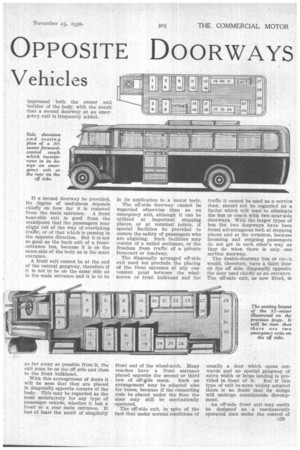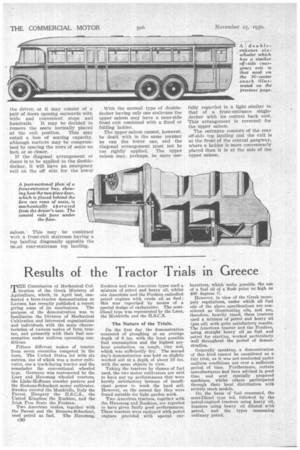A PLEA for DIAGONALLY
Page 50

Page 51

Page 52

If you've noticed an error in this article please click here to report it so we can fix it.
OPPOSITE DOORWAYS
On Passenger Vehicles
Our Coachbuilding Expert Makes a Thorough Study of the Subject of Double Doorways and Emergency Exits
THE doors of a passenger vehicle may be laid out in any one of the following arrangements :—
(1) Front near-side entrance with a central emergency exit in the middle of the back of the body.
(2) Rear near-side entrance and exit combined.
(3) One front and one rear doorway, both on the near side, the rear door being used as an entrance and the front one as an exit.
(4) An arrangement similar to No. 3, but the use of the doors is reversed and is chiefly adopted for coaches, which may often have a Second exit, regarded as an emer
gency one, on the off side, by the driver's seat.
A comparison of the outlined door arrangements reveals varying degrees of facility for entry and exit. From the point of view of the passengers' convenience and safety it would be reasonable to have, say, one door for buses and coaches up to a seating capacity of 14, two doors for vehicles accommodating from 14 to 30 passengers, and three doors for vehicles of greater capacity than 30 seats.
But at the present time seating capacity, although an important factor, is not the chief one for determining the number of entrances which a bus or coach shall have. With buses it is often the position of the main entrance which decides whether or not there shall be an additional doorway. • A front-entrance single-decker, whether it has .14 or 40 seats, always has a baek emergency door.
This is a reminder of the days when the fuel tank was under the driving seat and close to the main entrance. It has not the same significance nowadays, because the tank is usually slung lengthwise under the middle of the chassis, either on the near or off side.
The back emergency exit, however, is of value, because it provides a means for escape should the front entrance be obstructed or for any reason become unsafe, or it is desired to empty the vehicle quickly. Moreover, the back exit is not on the same side of the body as is the front entrance, therefore it is still available should the bus turn over on either of its sides.
The bus having a rear side entrance which also serves the purpose of an exit forms a strange contrast with the front-entrance one, because the former type is not only often a large single-decker, but it may also be the conventional design of double-decker. This somewhat illogical state of affairs has impressed both the owner and builder of the body, with the result that a second doorway or an emergency exit is frequently added.
If a second doorway be provided, Its degree of usefulness depends chiefly on how far it is removed from the main entrance. A front near-side exit is good from the standpoint that the passengers may alight out of the way of overtaking traffic, or of that which is passing in the opposite direction. But it is not so good as the back exit of a frontentrance bus, because it is on the same side of the body as is the main entrance.
A front exit cannot be at the end of the central gangway, therefore if it is not to be on the same side as is the main entrance and it is to be as far away as possible from it, the exit must be on the off side and close to the front bulkhead.
With this arrangement of doors it will be seen that they are placed in diagonally opposite corners of the body. This may be regarded as the most satisfactory for any type of passenger vehicle, whether it has a front or a rear main entrance. It has at least the merit of simplicity in its application to a motor body.
The off-side doorway cannot be regarded otherwise than as an emergency exit, although it can be Utilized at important stopping places, or at terminal points, if special facilities be provided to ensure the safety of passengers who are alighting. Such facilities may consist of a railed enclosure, or the freedom from traffic of a private forecourt or roadway.
The diagonally arranged off-side exit need not preclude the placing of the front entrance at any convenient point between the windscreen or front bulkhead and the front end of the wheel-arch. Many coaches have a front entrance placed opposite the second or third row of offiide seats. Such an arrangement may be adopted also for buses, because if the connecting rods be placed under the floor the door may still be mechanically operated. The off-side exit, in spite of the fact that under normal conditions of traffic it cannot be used as a service door, should not be regarded as a factor which will tend to eliminate the bus or coach with two near-side doorways. With the larger types of bus the two doorways have been found advantageous both at stopping places and at the terminus, because incoming and outgoing passengers do not get in each other's way as they do when there is only one service doorway. The double-doorway bus or cosk'h would, therefore, have a third door on the off side, diagonally opposite the door used chiefly as an entrance. The off-side exit, as now fitted, is usually a door which opens outwards and no special gangway of extra width or large landing is pro vided in front of it. But if this type of exit be more widely adopted there is no doubt that its design will undergo considerable development.
An off-side front exit may easily be designed as a mechanically operated door under the control of c29 the driver, or it may consist of a pair of doors opening outwards with wide and convenient steps and handrails. It may be decided to remove the seats normally placed at the exit position. This may entail a loss of seating capacity, although matters may be compromised by spacing the rows of seats an inch or so closer.
If the diagonal arrangement of doors is to be applied to the doubledecker, it will have an emergency exit on the off side for the lower saloon. This may be combined with a front-exit staircase having a top landing diagonally opposite the us:ial rear-staircase top landing. With the normal type of doubledecker having only one staircase the upper saloon may have a near-side front exit combined with a fixed or folding ladder.
The upper saloon cannot, however, be dealt with in the same manner as can the lower one, and the diagonal arrangement must not be too rigidly applied. The upper saloon may, perhaps, be more use
fully regarded in a light similar to that of a front-entrance singledecker with its central back exit. This arrangement is reversed for tile upper saloon.
The entrance consists of the rear off-side top landing anti the exit is at the front of the central gangway, where a ladder is more conveniently placed than it is at the side of the upper saloon.












































































































